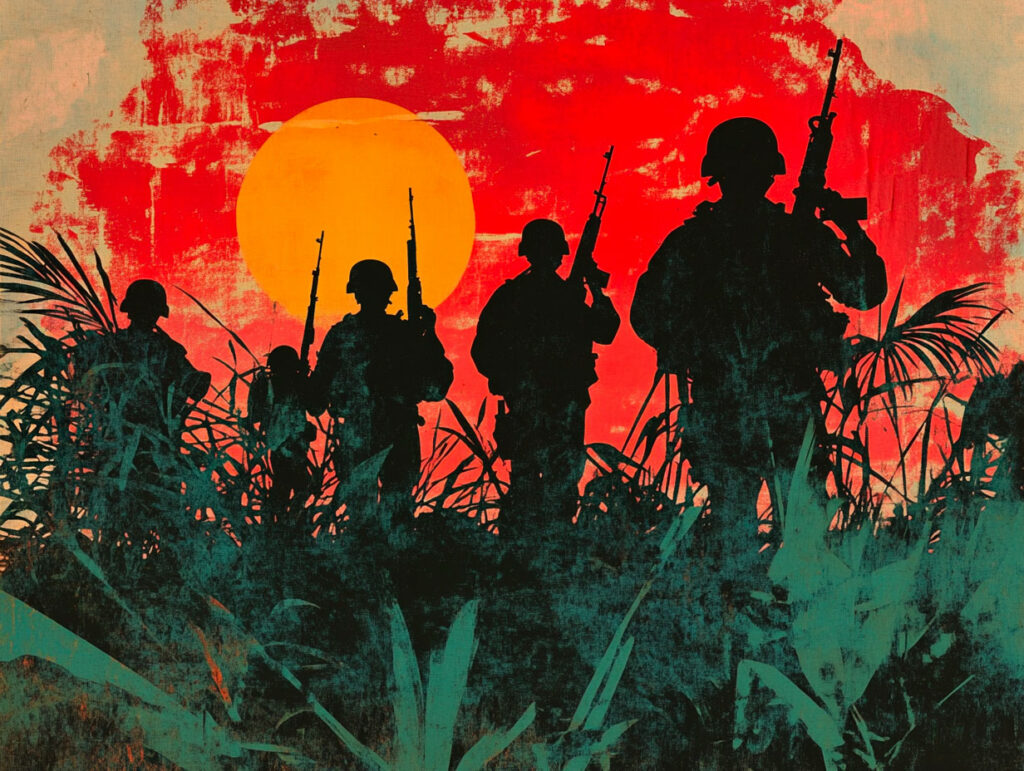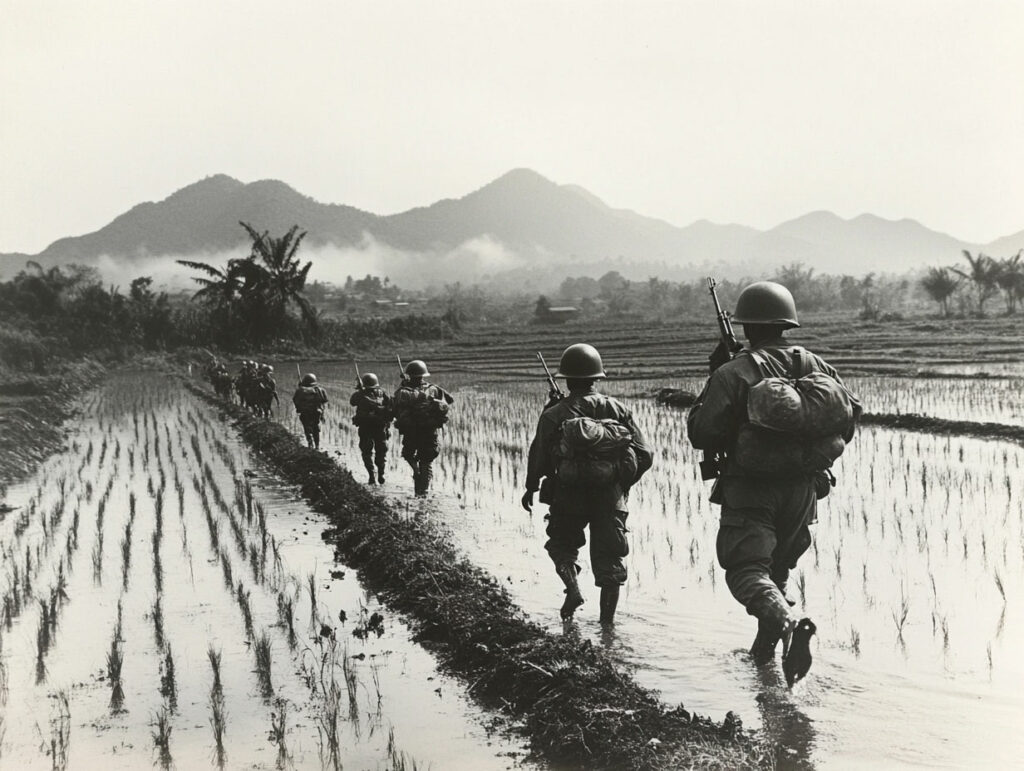Detailed analysis of the Vietnam War (1955–1975): its causes, key players, major battles, turning points, and consequences.
The Vietnam War (1955–1975) was a prolonged conflict between communist North Vietnam and anti-communist South Vietnam. It became a central front in the Cold War, with the United States supporting South Vietnam against the North, which was backed by the Soviet Union and China. Over three million people died, including more than 58,000 American soldiers. The war resulted in significant destruction and lasting effects on Vietnam and the world. It ended with the fall of Saigon in 1975, unifying Vietnam under communist rule. The war remains a key event in 20th-century history, illustrating the complexities of Cold War geopolitics and regional dynamics.
What Were the Reasons for the Vietnam War (1955–1975)
The Vietnam War was rooted in geopolitical, ideological, and historical factors. The immediate cause was the division of Vietnam after the First Indochina War. The 1954 Geneva Accords split the country at the 17th parallel, creating North Vietnam under communist leader Ho Chi Minh and South Vietnam under an anti-communist regime led by Ngo Dinh Diem.
The Cold War rivalry played a significant role. The United States feared the “domino theory,” which suggested that if one nation fell to communism, others in the region would follow. North Vietnam’s communist government sought to unify the country under its ideology, while the South resisted.
In South Vietnam, internal instability and dissatisfaction with Diem’s government exacerbated tensions. Diem’s policies alienated Buddhists and other groups, leading to civil unrest and weakening his administration. The Viet Cong, a communist insurgency in the South, gained strength, further destabilizing the region.
The global context of decolonization also influenced the conflict. Vietnam’s history of resisting foreign rule, including French and Japanese occupations, created a strong nationalist movement that fueled the North’s efforts.
Economic factors also contributed. Both sides relied heavily on foreign aid, deepening international involvement. The conflict became a proxy war between superpowers, with the U.S. supporting the South and the Soviet Union and China aiding the North.

Who Was Involved in the Vietnam War (1955–1975)?
The Vietnam War involved multiple nations and entities. North Vietnam, led by the Communist Party, sought to unify the country under its governance. Ho Chi Minh was its most prominent leader, symbolizing national resistance and communist aspirations.
South Vietnam, with support from the United States and allied nations, fought to maintain its sovereignty. Ngo Dinh Diem initially led the South but was overthrown in 1963. A series of unstable governments followed, weakening the anti-communist effort.
The United States became deeply involved, deploying more than 2.7 million troops over the course of the war. American forces provided military, financial, and advisory support to South Vietnam. Key allies included South Korea, Australia, New Zealand, Thailand, and the Philippines, all contributing troops or resources.
The Viet Cong, a communist guerrilla group in South Vietnam, played a critical role. Supported by North Vietnam, they conducted insurgency campaigns and controlled rural areas in the South.
The Soviet Union and China supported North Vietnam with weapons, funding, and training. Their involvement highlighted the Cold War’s global scope, where regional conflicts served as proxies for superpower rivalries.
Neutral nations like Cambodia and Laos were also affected. Both were drawn into the conflict, experiencing extensive bombing campaigns and political destabilization. The Ho Chi Minh Trail, a critical supply route for the North, passed through these countries, making them strategic targets.
The Leaders of the Vietnam War (1955–1975)
The Vietnam War featured influential leaders from multiple nations.
Ho Chi Minh, the leader of North Vietnam, was a key figure. A committed communist and nationalist, he spearheaded the independence movement against France and later against South Vietnam and its allies. His leadership inspired North Vietnamese forces.
Ngo Dinh Diem, the first president of South Vietnam, was a controversial figure. His anti-communist stance gained U.S. support, but his authoritarian policies and repression of dissent weakened his government. He was assassinated in 1963, leading to political instability.
Lyndon B. Johnson, the U.S. president from 1963 to 1969, escalated American involvement. His administration launched significant military operations, including the bombing campaigns of Operation Rolling Thunder.
Richard Nixon, Johnson’s successor, pursued “Vietnamization,” aiming to reduce U.S. troop levels while increasing South Vietnamese military responsibility. His administration also engaged in secret bombing campaigns in Cambodia and Laos.
General William Westmoreland, the commander of U.S. forces in Vietnam, implemented a strategy of attrition. He believed superior firepower could weaken North Vietnam and the Viet Cong, but his approach faced criticism for high casualties and lack of clear progress.
On the communist side, General Vo Nguyen Giap was a critical military leader. He orchestrated major campaigns, including the Tet Offensive, showcasing his strategic brilliance.
Was There a Decisive Moment?
The Vietnam War lacked a single decisive moment, but several events shifted its trajectory. The 1968 Tet Offensive was a critical point. North Vietnamese and Viet Cong forces launched widespread attacks across South Vietnam, targeting urban centers and U.S. military bases. While the offensive was a military failure for the North, it significantly eroded American public support for the war.
Another important moment was the 1963 assassination of Ngo Dinh Diem, which plunged South Vietnam into political chaos. The power vacuum weakened the South’s ability to resist communist forces effectively.
The 1969 My Lai Massacre, where U.S. troops killed hundreds of Vietnamese civilians, further undermined public support for the war. Media coverage of the incident highlighted the human cost of the conflict and intensified anti-war sentiment.
The 1973 Paris Peace Accords marked a diplomatic milestone. The agreement facilitated the withdrawal of U.S. troops and set conditions for a ceasefire. However, fighting continued between North and South Vietnam, culminating in the fall of Saigon in 1975.

Major Battles of the Vietnam War (1955–1975)
Several key battles defined the Vietnam War:
- Battle of Dien Bien Phu (1954): Although technically before the war’s official start, this battle ended French colonial rule in Vietnam and set the stage for the conflict.
- Battle of Ap Bac (1963): Viet Cong forces defeated a larger South Vietnamese force, showcasing their growing strength.
- Tet Offensive (1968): A massive coordinated assault by North Vietnamese and Viet Cong forces. It involved attacks on more than 100 cities and outposts, including the U.S. embassy in Saigon.
- Battle of Hue (1968): Part of the Tet Offensive, this urban battle lasted nearly a month and caused significant destruction.
- Easter Offensive (1972): A major North Vietnamese invasion targeting South Vietnam. It led to extensive bombing campaigns by U.S. forces.
- Fall of Saigon (1975): The final act of the war, where North Vietnamese forces captured Saigon, leading to South Vietnam’s surrender.
Was There a Turning Point?
The Tet Offensive is widely considered a turning point in the Vietnam War. Though it resulted in heavy losses for North Vietnam and the Viet Cong, the scale and intensity of the attacks shocked the American public. It contradicted official narratives that victory was near, leading to increased anti-war sentiment in the United States.
The U.S. strategy shifted after the offensive. President Johnson announced he would not seek re-election and began de-escalating U.S. involvement. The focus moved to “Vietnamization,” preparing South Vietnam to take over its defense.
Consequences of the Vietnam War (1955–1975)
The Vietnam War had profound consequences. Vietnam suffered immense destruction, with millions of deaths, widespread displacement, and significant damage to infrastructure. The use of chemical agents like Agent Orange caused long-term health and environmental impacts.
In the United States, the war divided public opinion and led to widespread anti-war protests. More than 58,000 American soldiers died, and thousands more returned with physical and psychological wounds.
The war reshaped U.S. foreign policy, fostering a more cautious approach to international interventions. It also exposed the limits of military power in achieving political goals.
Globally, the war affected Cold War dynamics. The Soviet Union and China strengthened ties with North Vietnam, while the U.S. faced criticism for its actions.
Vietnam’s reunification under communist rule transformed its political and economic systems. The war’s legacy continues to influence Vietnam’s development and its relations with other nations.
Back to the Wars section